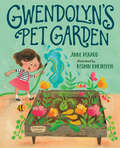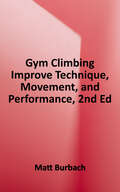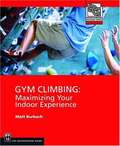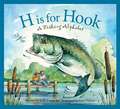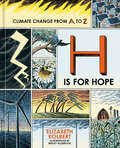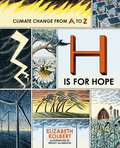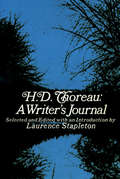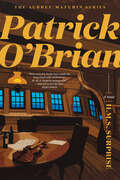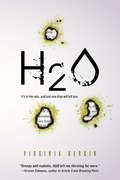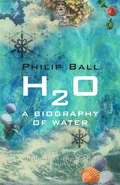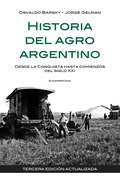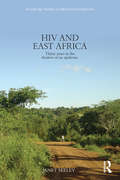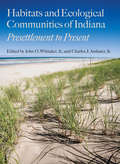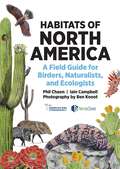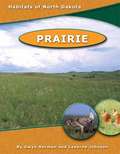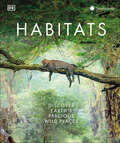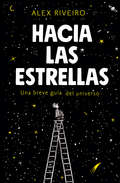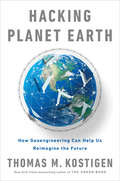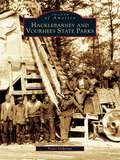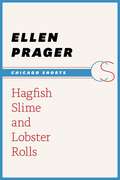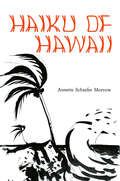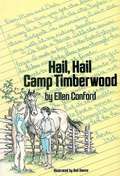- Table View
- List View
Gwendolyn's Pet Garden
by Anne RenaudA unique solution is found when a little girl dreams of getting a pet.Gwendolyn longs for a pet. What kind? Any kind! How many legs? Two, four, ten--she's not picky! But her parents have other ideas, and instead they give her . . . a box of dirt. "It smells of swamp," Gwendolyn says--but her parents say it smells of possibilities. And once Gwendolyn gets savvy about seeds and soil, sun and shade, she finds they are right. The dirt starts performing some amazing tricks, and soon she has a whole pet garden of her very own--it might not have "any legs at all, but it was alive, and Gwendolyn could talk to it, care for it, and watch it grow."Dynamic illustrations full of funny details show the love Gwendolyn puts into caring for her "pet," and her enthusiasm and pride are sure to inspire gardeners and aspiring gardeners alike.
Gym Climbing: Improve Technique, Movement, and Performance
by Matt BurbachClimbing has become a mainstream sport with more participants than skiing or snowboarding and, among the different types of climbing, gym climbing is the most popular. Where gyms were once a training ground for rock and alpine climbers, many participants now regularly climb indoors with no plans beyond tackling the ever-changing routes of their neighborhood hangout. <P><P>When Mountaineers Books published the first edition of this title in 2004 there were approximately 250 climbing gyms in the United States. Today there are more than 650. In this completely revised second edition, author Matt Burbach focuses his instruction on climbers who want to excel on indoor routes and problems. <P><P>The new edition includes: Step-by-step training for beginners - Strategies for progressing to dynamic movements to top out on ever more difficult new-school routes and problems - Both bouldering and top-roping instruction -Physical conditioning, mental training, and kinesiological assessment and theory -The latest belay and safety techniques - Explanation of equipment, which is safer, lighter, and more comfortable than ever. <P><P>This edition also includes entirely new photos (now in color), with professional climbers Emily Harrington and Matt Segal demonstrating the moves and gym climbing techniques throughout the book.
Gym Climbing: Maximizing Your Indoor Experience
by Matt BurbachGym climbing has evolved into a sport in its own right and Matt Burbach has been there to spur it on. Burbach covers all aspects of indoor rock climbing in detail, including what to look for in a gym, analysis of equipment and how it works, proper top-rope systems management, and movement technique. More advanced indoor climbers will appreciate chapters on topics such as indoor leading, performance, competition climbing, and bouldering. For outdoor rock climbers now training in gyms, this guide aids the "reverse" transition from climbing on real rock to pulling on plastic. Throughout, Burbach not only demonstrates the proper techniques and skills, but goes one step further to explain why those practices are better.
H Is for Hook: A Fishing Alphabet
by Judy YoungFrom A to Z all that is fishing is explained in this illustrated picture book using poetry and prose. Topics include angler, catch and release, fly-fishing, tackle, and more.
H Is for Hope: Climate Change from A to Z
by Elizabeth KolbertIn twenty-six essays—one for each letter of the alphabet—the Pulitzer Prize-winning author of The Sixth Extinction takes us on a hauntingly illustrated journey through the history of climate change and the uncertainties of our future.Climate change resists narrative—and yet some account of what&’s happening is needed. Millions of lives are at stake, and upward of a million species. And there are decisions to be made, even though it&’s unclear who, exactly, will make them.In H Is for Hope, Elizabeth Kolbert investigates the landscape of climate change—from &“A&”, for Svante Arrhenius, who created the world&’s first climate model in 1894, to &“Z&”, for the Colorado River Basin, ground zero for climate change in the United States. Along the way she looks at Greta Thunburg&’s &“blah blah blah&” speech (&“B&”), learns to fly an all-electric plane (&“E&”), experiments with the effects of extreme temperatures on the human body (&“T&”), and struggles with the deep uncertainty of the future of climate change (&“U&”).Adapted from essays originally published in The New Yorker and beautifully illustrated by Wesley Allsbrook, H Is for Hope is simultaneously inspiring, alarming, and darkly humorous—a unique examination of our changing world.
H is for Hope: Climate Change from A to Z
by Elizabeth KolbertClimate change resists narrative – and yet we must see clearly what&’s happening in our world. Millions of lives are at stake, and upwards of a million species. We must act. 'To be a well-informed citizen of Planet Earth, you need to read Elizabeth Kolbert.' ROLLING STONE In H is for Hope, Elizabeth Kolbert investigates the history, and future, of climate change – from A, for Svante Arrhenius, who created the world&’s first climate model in 1894, to Z, for Net Zero. Along the way she looks at Greta Thunberg&’s &‘blah blah blah&’ speech, flies an all-electric plane, experiments with the effects of extreme temperatures on the human body, and struggles with the deep uncertainty of the future. Complemented by Wesley Allsbrook&’s gorgeous, colour illustrations, H Is for Hope offers an inspiring, worrying and, above all, hopeful vision for how we can still save our planet.
H. D. Thoreau, a Writer's Journal
by Laurence StapletonTimeless observations on the craft of writing, taken from Thoreau's journals--conditions required, method of creation, ideals and purpose of his art, etc. Also, experiments in style which culminated in Thoreau's classic Walden. Foreword. Introduction. Selected Bibliography. Index.
H. M. S. Surprise (Aubrey/Maturin Novels #3)
by Patrick O'Brian"Few, very few books have made my heart thud with excitement. H.M.S. Surprise managed it." —Helen Lucy Burke, Irish Press In H.M.S. Surprise, British naval officer Jack Aubrey and surgeon Stephen Maturin face near-death and tumultuous romance in the distant waters ploughed by the ships of the East India Company. Tasked with ferrying a British ambassador to the Sultan of Kampong, they find themselves on a prolonged voyage aboard a Royal Navy frigate en route to the Malay Peninsula. In this new sphere, Aubrey is on the defensive, pitting wits and seamanship against an enemy who enjoys overwhelming local superiority. But somewhere in the Indian Ocean lies the prize that could secure him a marriage to his beloved Sophie and make him rich beyond his wildest dreams: the ships sent by Napoleon to attack the China Fleet.
H2O
by Virginia Bergin.27 is a number Ruby hates.It's a number that marks the percentage of the population that has survived. It's a number that means she's one of the "lucky" few still standing. And it's a number that says her father is probably dead. Against all odds, Ruby has survived the catastrophic onset of the killer rain. Two weeks after the radio started broadcasting the warning, "It's in the rain. It's fatal and there's no cure," the drinkable water is running out. Ruby's left with two options: persevere on her own, or embark on a treacherous journey across the country to find her father-if he's even still alive.
H2O: A Biography of Water
by Philip BallThe brilliantly told and gripping story of the most familiar - yet, amazingly, still poorly understood - substance in the universe: Water.The extent to which water remains a scientific mystery is extraordinary, despite its prevalence and central importance on Earth. Whether one considers its role in biology, its place in the physical world (where it refuses to obey the usual rules of liquids) or its deceptively simple structure, there is still no complete answer to the question: what is water? Philip Ball's book explains what, exactly, we do and do not know about the strange character of this most essential and ubiquitous of substances.H20 begins by transporting its readers back to the Big Bang and the formation of galaxies to witness the birth of water's constituent elements: hydrogen and oxygen. It then explains how the primeval oceans were formed four billion years ago; where water is to be found on other planets; why ice floats when most solids sink; why, despite being highly corrosive, water is good for us; why there are at least fifteen kinds of ice and perhaps two kinds of liquid water; how scientists have consistently misunderstood water for centuries; and why wars have been waged over it.Philip Ball's gloriously offbeat and intelligent book conducts us on a journey through the history of science, folklore, the wilder scientific fringes, cutting-edge physics, biology and ecology, to give a fascinating new perspective on life and the substance that sustains it. After reading this book, drinking a glass of water will never be the same again.
HISTORIA DEL AGRO ARGENTINO (EBOOK)
by O. Gelman BarskyA pesar de la importancia que tiene el agro en la sociedad argentina, han sido escasos los intentos de indagar en su evolución a lo largo de la historia. Este libro construye una síntesis del desarrollo rural de todo el país: comienza con el análisis de las comunidades indígenas y continúa con la construcción del mundo agrícola colonial, la conformación de las nuevas economías agrarias a partir de la independencia, la expansión ganadera en la primera mitad del siglo XIX y el crecimiento de distintas economías regionales. El estudio avanza sobre el notable desarrollo del agro pampeano y el auge de la producción azucarera del noroeste y vitivinícola de Cuyo, así como las de otras sociedades del interior. Asimismo, son analizados los efectos de la Primera Guerra Mundial y de la crisis internacional de los años 30 en las políticas y las dinámicas agrarias. La caída de la producción agrícola pampeana y los cambios sociales desatados en esta región en el contexto de la Segunda Guerra Mundial, y el posterior período de recuperación, junto a los avances de las producciones regionales se presentan detalladamente. Finalmente, el impacto de las medidas macroeconómicas en la reorganización del ámbito rural en las últimas décadas, incluido el conflicto por el excedente agrario que sacudió al país en 2008, cierra este libro en el que los autores ofrecen una visión completa y profunda de un sector decisivo en el pasado y presente de la Argentina.
HIV and East Africa: Thirty Years in the Shadow of an Epidemic (Routledge Studies in African Development)
by Janet SeeleyBy tracing the shadow of the epidemic over the last 30 years in Uganda and more broadly in the region, HIV and East Africa investigates the impact of the epidemic on people’s lives and livelihoods, placing the epidemic within the context of the social, political and economic changes that have occurred over the last three decades. Whilst it inevitably touches on loss and suffering, the message is also about managing the impact of an epidemic which has had a profound impact on many lives. When one looks for traces in southern Uganda, once thought to be the epicentre of the epidemic, it is hard to see any lasting impact at a community wide level. Delve deeper and there are scars to be found among families and patterns of change which are a direct result of the epidemic The book goes on to explore the effect of improved treatment and care on perceptions of the epidemic and concludes by putting HIV into the context of other disease outbreaks, reflecting on what we can learn from the history of other epidemics as well as the last 30 years of the HIV epidemic.
Habitat Fragmentation and Landscape Change: An Ecological and Conservation Synthesis
by David B. Lindenmayer Joern FischerHabitat loss and degradation that comes as a result of human activity is the single biggest threat to biodiversity in the world today. Habitat Fragmentation and Landscape Change is a groundbreaking work that brings together a wealth of information from a wide range of sources to define the ecological problems caused by landscape change and to highlight the relationships among landscape change, habitat fragmentation, and biodiversity conservation. The book: *synthesizes a large body of information from the scientific literature *considers key theoretical principles for examining and predicting effects *examines the range of effects that can arise *explores ways of mitigating impacts *reviews approaches to studying the problem *discusses knowledge gaps and future areas for research and management Habitat Fragmentation and Landscape Change offers a unique mix of theoretical and practical information, outlining general principles and approaches and illustrating those principles with case studies from around the world. It represents a definitive overview and synthesis on the full range of topics that fall under the widely used but often vaguely defined term "habitat fragmentation."
Habitats and Ecological Communities of Indiana
by Jr. John O. Whitaker Jr. Charles J. Amlaner Jr. George R. Parker Peter E. Scott Marion T. JacksonIn Habitats and Ecological Communities of Indiana, leading experts assess the health and diversity of Indiana's eight wildlife habitats, providing detailed analysis, data-generated maps, color photographs, and complete lists of flora and fauna. This groundbreaking reference details the state's forests, grasslands, wetlands, aquatic systems, barren lands, and subterranean systems, and describes the nature and impact of two man-made habitats--agricultural and developed lands. The book considers extirpated and endangered species alongside invasives and exotics, and evaluates floral and faunal distribution at century intervals to chart ecological change.
Habitats of North America: A Field Guide for Birders, Naturalists, and Ecologists (Habitats of the World)
by Phil Chaon Iain CampbellA richly illustrated field guide to all of North America&’s major habitats—packed with invaluable information to help you get the most out of your outdoor adventuresWhether you&’re a birder, naturalist, outdoor enthusiast, or ecologist, knowing the surrounding habitat is essential to getting the most out of your experiences in the field. This compact, easy-to-use guide provides an unparalleled treatment of the wonderfully diverse habitats of North America. Incisive and up-to-date descriptions cover the unique features of each habitat, from geology and climate to soil and hydrology. Requiring no scientific background, Habitats of North America offers quick and reliable information for anyone who wants a deeper understanding and appreciation of the habitats around them.Covers 81 major North American habitats, including wetlands and oceanic habitatsFeatures hundreds of color photos of habitats and their wildlife, a wealth of helpful diagrams and illustrations, and a detailed distribution map for each land habitatConcise text provides all the information you need to identify and understand habitats anywhere in North America quickly and accuratelyDiscusses iconic and indicator species of birds, mammals, and plantsIncludes an in-depth section on habitat classification—invaluable for ecologistsRepresentative habitat accounts describe what you can expect to see and experience thereFormatted like a field guide for easy reference
Habitats of North Dakota Prairie
by Gwyn Herman; Laverne JohnsonThe information presented in Habitats of North Dakota seeks to promote teaching and learning about the wildlife and conservation topics of North Dakota. Five separate units have been developed to discuss the habitats. They are Wetlands, Prairie, Badlands, Woodlands, and Riparian Areas.
Habitats of the World (DK Panorama)
by DKTake a tour through Earth&’s most amazing habitats and discover the astonishing variety of life on our planet.From forests and ocean to deserts and the frozen Poles, explore Earth&’s major ecosystems and the different communities of animals and plants that live in each one.Illustrated in incredible detail with CGI images, children aged 7-11 will pore over the pages of this breathtaking visual journey through Earth&’s incredible ecosystems. Dip beneath the sunlit surface of the Coral Sea to discover a reef bursting with life. Voyage to the frozen north to find out which animals survive on the icy Arctic tundra. See the sunrise over the Sonoran Desert in spring as this arid landscape bursts into bloom. Find out how animals and plants are adapted to their environment and how they interact with their surroundings and each other, from a teeming tropical rainforest to the hostile conditions of a high mountain peak or the icy Poles. This incredible nature book for children features: 14 stunning double-page CGI illustrations, each showcasing a different habitat from across the world, from the Arctic to Australia. Details from the main scene are pulled out and placed around the edges of the page for readers to find in the illustration and to give extra information. All of Earth&’s major habitats and the animals and plants that live there.A lively and engaging introduction text guides the reader through each habitat, and draws out details from the artwork.SI Habitats of the World is for anyone fascinated by the incredible diversity of life on Earth, perfect for children and parents to read together. Packed full of natural wonders and iconic animal species, this book shows how life on Earth is interconnected and knitted together in a delicate balance.
Habitats: From Ocean Trench to Tropical Forest
by DKCelebrates and explains the astonishing range of habitats on Earth and the intricate balance of their animal and plant communitiesThis book is a beautiful visual reference to the world&’s natural habitats and the plants and animals that live there. It explores global habitat types, including desert, Arctic tundra, and tropical forest – and distinctive regional habitats, such as the windswept puna grasslands of the Andes or the dripping, fern-clad rainforests of New Zealand. Packed with fascinating illustrations, the book analyzes how each habitat works and examines its unique combination of plants and animals, along with the features that suit them to live there. It then goes deeper, telling stories about how the inhabitants relate to one another and interact. Stories are told using images and graphics, showing what is going on in the natural ecosystem. The stories include survival strategies and life cycles, how pollinators fertilize plants, and how animals distribute the seeds, how similar species divide up food or living space to avoid competition, and how some species cooperate in intimate partnerships.Earth&’s pristine wildernesses are dwindling, so the book includes national parks, wildlife reserves, and other protected areas, and the conservation efforts needed to preserve our precious biological diversity.
Hacia las estrellas: Una breve guía del universo
by Álex Riveiro¿Cómo de grande es el universo? ¿Podremos algún día viajar a otras estrellas? ¿Qué es un agujero negro? ¡Descúbrelo con este libro! ¿Alguna vez has levantado la vista al cielo en una noche estrellada y te has dejado llevar por la imaginación? Igual en ese momento te has trasladado a mundos que van más allá de lo que podemos imaginar en la Tierra. Algunos con vida, puede que inteligente, y otros completamente inhóspitos e infernales. O quizá simplemente te has preguntado cuántas estrellas hay en la Vía Láctea. Si alguna vez te has hecho alguna de estas preguntas, este libro es para ti. De la mano de Alex Riveiro, creador de Astrobitácora, el blog de referencia de astronomía en español.
Hacking Planet Earth: How Geoengineering Can Help Us Reimagine the Future
by Thomas M. KostigenAn exploration of the cutting-edge technology that will enable us to confront the realities of climate change.For decades scientists and environmentalists have sounded the alarm about the effects of global warming. We are now past the tipping point. As floods, storms, and extreme temperatures become our daily reality, "Reduce, Reuse, Recycle" efforts aren't enough anymore. In Hacking Planet Earth, New York Times bestselling author Thomas Kostigen takes readers to the frontlines of geoengineering projects that scientists, entrepreneurs, engineers, and other visionaries around the world are developing to solve the problems associated with climate change. From giant parasols hovering above the Earth to shield us from an unforgiving sun, to lasers shooting up into clouds to coax out much-needed water, Kostigen introduces readers to this inspiring work and the people who are spearheading it. These futurist, far- thinking, world-changing ideas will save us, and Hacking Planet Earth offers readers their new vision for the future.
Hacklebarney and Voorhees State Parks (Images of America)
by Peter OsborneHacklebarney and Voorhees State Parks recounts the history of two beautiful natural sanctuaries at the southwestern end of New Jersey's Highlands. Managed as a single unit by the state park service, the two parks are Hacklebarney, 977 acres along the Black River corridor, and Voorhees, 640 acres of gently rolling farmland. Their stories are similar: both parks were created in the 1920s on privately donated land and were developed by the federally operated Civilian Conservation Corps. With more than two hundred unique photographs, many published here for the first time, Hacklebarney and Voorhees State Parks shows life at the CCC camps, the building of trails and roads by hand, and the repair of forests.
Hagfish Slime and Lobster Rolls (Chicago Shorts)
by Ellen PragerWhen viewed from a quiet beach, the ocean, with its rolling waves and vast expanse, can seem calm, even serene. But hidden beneath the sea’s waves are a staggering abundance and variety of active creatures, engaged in the never-ending struggles of life—to reproduce, to eat, and to avoid being eaten. With Hagfish Slime and Lobster Rolls, marine scientist Ellen Prager takes us deep into the sea to introduce an astonishing cast of fascinating and bizarre creatures that make the salty depths their home, with the help of stunning color photos. From the lobsters that battle rivals or seduce mates with their urine to hagfish that ties itself into a knot to keep from suffocating in its own slime—there’s far more to Prager’s account than her ever-entertaining anecdotes. Again and again, she illustrates the crucial connections between life in the ocean and humankind, enchanting us as she educates, enthralling us with the wealth of life in the sea, and reminding us of our need to protect it.
Haiku of Hawaii
by Annette Schaefer MorrowLet yourself be guided through the different seasons and places of Hawaii by a fresh voice in haiku poetry.
Hail, Hail Camp Timberwood
by Ellen ConfordRelates the experiences of 13-year-old Melanie as she tries to cope with the traumas and pleasures of her first year at summer camp.
Hailstones and Halibut Bones
by Mary O'NeillThe Colors live Between black and white In a land that we Know best by sight. But knowing best Isn't everything, For colors dance And colors sing, And colors laugh And colors cry- Turn off the light And colors die, And they make you feel Every feeling there is From the grumpiest grump To the fizziest fizz. And you and you and I Know well Each has a taste And each has a smell And each has a wonderful Story to tell....
